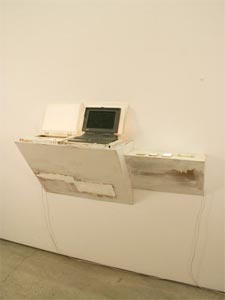
For "Monitor," at New York's Claire Oliver, Brooklyn-based artist Noah Fischer produces a refreshingly rough-hewn body of sculptures that reflect the variegated meaning of his titular product. The monitor here operates at the threshold of objecthood, given both that "we gaze into its pixilated illusion, never directly at its shape and mass" and because the pace of technological development and consumption finds each new screen soon devolving into "e-waste." Boxy, beige monitors congregate in the aptly titled sculpture, Trash Pile, and are shown discarded on sidewalks in some of the black-and-white print-outs comprising wall sculpture Map Installation. Fischer finds a resurgence of Modernist aesthetics in subsequent generations of product design, most notably in those of Apple's laptops and iPhone. With their Judd-esque manufacture and seemingly infinite functions, they market a "sublime promise" all but removed from their production history, as well as from the "global trash cycle." In general, Fischer's sculptures ably marry the tenants of display and the realities of consumption. The crudely painted, triangular shelving of Family Portrait and New Codes could be the unwashed brethren of Steinbach's, the former topped with two wood shells of the new Mac PowerBook. An actual, grandfatherly PowerBook 180 has carved out a seat from one of them, while the translucent screens of an adjacent coterie handheld units glow from beneath. Perfect Lantern makes the reference explicit, as a strip of recessed lighting fills a wood PowerBook's translucent screen, and thus economically stages the condition of immateriality that gives the monitor its unstable nature. - Tyler Coburn
Image: Noah Fischer, Family Portrait, 2008


Thank you for a great review